Have you ever wondered were slate comes from? Now the slate I am referring to is the type that is used on roofs. There are many different kinds of Slate roofing as you find out from this post. Slate roofing is normally named by the origin of where it came from. In the united states they are still being quarried in
Virginia, Pennsylvania, New York, and Vermont.
But, Did you know that a century ago there were hundreds more American slate
quarries than there are today, including in Maine and Georgia. And each one produced a different color and texture. Most your professional slate roofing contractors can tell you where it came from just by looking at it.
Slate is made a lot differently theses days with new modern technology. But I remember reading that at a long time ago when limestone was used. They would pull the limestone out of the ground and some times have to go up to 70 feet deep to get it. It would be in a block that was refereed to as a pendle, and let it sit in a field and absorb water. And they would pile dirt on top of it and pore water on top of it to help with this proses.
They would do this over the course of a few years!. I know right, that's a long time to wait. Over the course of a few cold winters the water that had absorbed would penetrate and split the stone in to usable pieces.
The Picture above is a gazebo that is using the limestone roofing that I just spoke of. Buckingham slates (below), or Virginia slates, are a gray-black slate with a life expectancy of about 150 years, maybe more. You will see the glint of countless tiny silica crystals in this slate when viewed in the sun, a unique characteristic of Buckingham slate.
Slate is mainly composed of the minerals quartz and muscovite or illite, often along with biotite, chlorite, hematite, and pyrite and, less frequently apatite, graphite, kaolinite, magnetite, tourmaline, or zircon as well as feldspar. Occasionally, as in the purple slates of North Wales, ferrous reduction spheres form around iron nuclei, leaving a light green spotted texture. These spheres are sometimes deformed by a subsequent applied stress field to ovoids, which appear as ellipses when viewed on a cleavage plane of the specimen.
Always remember when having your slate or tile roof looked at or worked on you need to have a real slate and tile roofing contractor to do the work other wise it will cost you more money to get it done right. Below is a picture of a slte roof repaired by a asphalt shingle roofer who didn't have the right tools or the knowledge to do the repair.
an informative slate and tile roofing blog geared to help home owners with slate or tile roofing systems
Sunday, March 31, 2013
Friday, March 29, 2013
Tile Roofing & The Installation Of
Today we will go over the installation proses, step by step of a Spanish tile roof. But before we do, we want to thank Scott Morrow of Scott Morrow Slate & Tile Roofing & Repairs of Atlanta Georgia for letting us use his photos for the purpose of this informative blog. You can Go visit Scott morrow @ www.scottmorrowroofing.com
The first step in the installation of Spanish Tile is making sure that the decking is sound.If there is any water damage it is recommended to replace the damaged area's.
If you have tore of an existing roof you need to make sure all the existing nails are removed. If you don't then when you apply a water proofing layer of felt, It will poke unwanted holes in it. So after all the decking is replaced and the nails are pulled you will have your starting point.
You will want to apply a layer of felt over the entire decking leaving nothing exposed. Roofing felt has been in use for over a hundred years. Originally felt was made from recycled rag but today felts are made of recycled paper products (typically cardboard) and sawdust. There is 15 # and 30 # felt, most people will use a 30 #, I have seen some contractors use a double layer of 15 # felt to make it 30#.
And once the felt is on you will next cover the entire roof in a asphalt base called rolled roofing. It is referred to as roll roofing because of the way it is applied. It is rolled on in the same way the felt is. This is a second line of defense.
After the entire roof is covered in roll roofing, the next step is to start preparing it to start laying tile. The drip edge should already be in place seeing that you already have the roll roofing applied.
This is a great example of a non riser installation. you can see the whole breakdown from the felt to the roll roofing and on to the tile. Now while most, and not all of these photos were given to us by Scott Morrow to use in this informative blog, we would like to say thanks. And to the readers, keep in mind that you always want to hire a experienced slate and tile roofing contractor to work on your slate or tile roof.
The first step in the installation of Spanish Tile is making sure that the decking is sound.If there is any water damage it is recommended to replace the damaged area's.
If you have tore of an existing roof you need to make sure all the existing nails are removed. If you don't then when you apply a water proofing layer of felt, It will poke unwanted holes in it. So after all the decking is replaced and the nails are pulled you will have your starting point.
You will want to apply a layer of felt over the entire decking leaving nothing exposed. Roofing felt has been in use for over a hundred years. Originally felt was made from recycled rag but today felts are made of recycled paper products (typically cardboard) and sawdust. There is 15 # and 30 # felt, most people will use a 30 #, I have seen some contractors use a double layer of 15 # felt to make it 30#.
And once the felt is on you will next cover the entire roof in a asphalt base called rolled roofing. It is referred to as roll roofing because of the way it is applied. It is rolled on in the same way the felt is. This is a second line of defense.
After the entire roof is covered in roll roofing, the next step is to start preparing it to start laying tile. The drip edge should already be in place seeing that you already have the roll roofing applied.
Depending on the type of tile used you will need to place strips of wood on the roof to nail the tile on too.These are called risers. The fist thing you put on is the bird stops. They are placed on the roofs eave and they are to keep birds from getting under the tiles and nesting. There are many different types that you can use. Some use clay one's and today there are many different types manufactured.
In the next picture you will see a example of a Spanish tile roof being installed on risers and with bird stops manufactured out of metal vented.
I also wanted to show you how some tile is also installed with out risers and the next picture is a great example.
Thursday, March 28, 2013
Copper Roofing & The Fabrication of
When copper is used on a roof and is fabricated and installed correctly It is beautiful. You will find that your typical asphalt shingle roofing system does not have copper any where on it. When a metal is used on a asphalt shingle roofing system it is usually a cheaper metal such as tin or galvanized. And that would be used on the areas that require metal such as your drip edge and flashing.
You will find the use of copper on your more expensive roofing systems, such as slate and tile. Depending on the type of slate or tile used, these roofs have a 50-100 + year life span so the metal used needs to last longer then, say tin or galvanized. Copper is the answer to that needed life span. Copper is used in several different areas on a slate and tile roof system.
The use of copper is needed in the valleys on a slate and tile roof, It is also used for the drip edge and needed flashing for walls or chimneys. And you will also find that a lot of home owners choose to use it when it comes to the fabrication of the chimney cap.
And from the photo above you can see that it is also used to make custom ridge caps. Some home owners choose not to do this out of taste or there budget, but if you ask me I think it makes a slate roof look great. You can also see the use of copper in the valley as well in this photo.
Copper is also used in a couple different ways on parts of the roof that have little to no pitch. Some home owners choose to use a modified rubber application on these, and again ether there taste or there budget is the reason for this choice. But again, for me copper is the better choice. There is a method called standing seam, and that is where the different panels meet and are folded over each other.
Now the next method is a flat locking method which requires each joint to be soldered. I'm not as a big of fan of this method as I am of the standing seam method merely out of looks. But that is just my opinion and if it were out of site and no one could see it I guess it would be ok. Have a look for your self.
Its not that it looks bad, I just think standing seam looks better is all. Now copper is also used in gutters. typically a slate and tile roof follow suit with copper gutters as well. and they are beautiful as well too.
Here you see what is called half round gutter system. And with a copper gutter system I think it helps to complement the house along with the copper that is used on the roof.
Now in this photo above you will see a box style gutter made from copper. And while it looks good I prefer the half round style over this one. Now there are some amazing gutter systems called hidden gutters or some call them built in gutters. These are gutters that are built in to the roof and not hung on the side of the fascia board. These are some beautiful gutter systems when done right. Take a look for your self.
Here in the next photo is one on a slate roof that has a nice radius to it.
So as you can see copper is used all over in different applications on slate and tile roofing systems. The copper used is a typically a 20 oz. copper and it is beautiful when installed and over time it will start turning to a nice patina. I hope you enjoyed this informative post on copper. And remember when hiring anyone to work on your slate or tile roof, make sure they have a slate and tile background before you let them on your roof.
You will find the use of copper on your more expensive roofing systems, such as slate and tile. Depending on the type of slate or tile used, these roofs have a 50-100 + year life span so the metal used needs to last longer then, say tin or galvanized. Copper is the answer to that needed life span. Copper is used in several different areas on a slate and tile roof system.
The use of copper is needed in the valleys on a slate and tile roof, It is also used for the drip edge and needed flashing for walls or chimneys. And you will also find that a lot of home owners choose to use it when it comes to the fabrication of the chimney cap.
And from the photo above you can see that it is also used to make custom ridge caps. Some home owners choose not to do this out of taste or there budget, but if you ask me I think it makes a slate roof look great. You can also see the use of copper in the valley as well in this photo.
Copper is also used in a couple different ways on parts of the roof that have little to no pitch. Some home owners choose to use a modified rubber application on these, and again ether there taste or there budget is the reason for this choice. But again, for me copper is the better choice. There is a method called standing seam, and that is where the different panels meet and are folded over each other.
Now the next method is a flat locking method which requires each joint to be soldered. I'm not as a big of fan of this method as I am of the standing seam method merely out of looks. But that is just my opinion and if it were out of site and no one could see it I guess it would be ok. Have a look for your self.
Its not that it looks bad, I just think standing seam looks better is all. Now copper is also used in gutters. typically a slate and tile roof follow suit with copper gutters as well. and they are beautiful as well too.
Here you see what is called half round gutter system. And with a copper gutter system I think it helps to complement the house along with the copper that is used on the roof.
Now in this photo above you will see a box style gutter made from copper. And while it looks good I prefer the half round style over this one. Now there are some amazing gutter systems called hidden gutters or some call them built in gutters. These are gutters that are built in to the roof and not hung on the side of the fascia board. These are some beautiful gutter systems when done right. Take a look for your self.
Here in the next photo is one on a slate roof that has a nice radius to it.
So as you can see copper is used all over in different applications on slate and tile roofing systems. The copper used is a typically a 20 oz. copper and it is beautiful when installed and over time it will start turning to a nice patina. I hope you enjoyed this informative post on copper. And remember when hiring anyone to work on your slate or tile roof, make sure they have a slate and tile background before you let them on your roof.
Sunday, March 24, 2013
Hiring The Wrong Slate or Tile Roofing Contractor
Did you know that there is a large percentage of roof damage that is caused by roofing contractors that don't Know what there doing? Its true, hiring the wrong contractor to work on your slate or tile roof can be detrimental. Not only to your roof but too your wallet as well. Let me help illustrate with a few photos.
This is called a cricket, it diverts water away from the chimney as it flows down from behind it. As you can see it is real sloppy work. Now our first goal as a roofing contractor is to make it water tight, yes... but the second is to make it LOOK GOOD ! Just because you cant see it from the ground does not mean you shouldn't take pride in your work. Lets see if we can find a cricket installed properly.
Now you cant tell me that is not beautiful. That is a roofing contractor who takes pride in his work. Scott Morrow from Scott Morrow Slate & Tile Roofing & Repairs Of Atlanta Georgia installed this cricket. There are a lot of roofers out there, but when it comes to slate or tile you need to make sure you get the right one. And by the right one I mean one that has a background in slate and tile! Don't hire a asphalt roofing contractor to work on your slate or tile roof. Other wise you get work that looks like the next picture.
LOL! Now one can only guess whats going on here. It looks like the contractor didn't have the right material or the right tools to fix this plumbing boot the correct way, so he just put roofing tar all over it. And if you look real close it looks like he also put a Styrofoam cup in the top of it. I'm guessing that that plumbing stack is no longer in use from plumbing upgrades, just a guess. He still could have made it look better. and that roofing tar does not have as long of life span as copper. This next picture looks better.
See when you hire a qualified slate and tile roofing contractor, they have the right tools and material for the job. When you hire a contractor that does not have what he needs for the job you get repairs that look like the next picture.
There is a special tool used just to remove the slate. Its a really thin and long tool designed to slide under the slate and hook on the nails. Then it is hammered on until the nail pulls out. Then the piece of slate slides out. When the contractor does not have this tool you usually get whats in the picture above.
In the picture above is a slate ripper being used. See you cant lift the slate up to get to the nails to remove them like you can on asphalt shingles. And you cant get get under the slate to nail in the piece you just replaced ether, so a copper hook is nailed in to the roof where the slate would sit and hold it in place.
You can see the copper hooks used in the photo above. That is how a proper slate roof repair should look. In the next photo we will illustrate a tile repair from a contractor who didn't have the right material to do the repair the right way so he just used a piece of asphalt roofing. My guess is that he was a asphalt roofing contractor seeing that's what he used. What do you think?
Now the next picture is of a ridge cap that was repaired wrong. I personally love a copper ridge cap but like It might not appeal to every one. In cases when a copper ridge cap is not used then some sort of metal should be used underneath the slate where the two sides of the ridge meet.
In this photo you can see where they used felt paper. Felt paper is used to cover the decking of a roof as a second line of defense and is not meant to be exposed to the elements. And when it is exposed it deteriorates a lot faster.
We hope this has been informative. Keep in mind to hire a slate and tile contractor to work on you slate or tile roof. To see more of Scott Morrow Slate & Tile Roofing & Repairs work you can visit him at his website.
This is called a cricket, it diverts water away from the chimney as it flows down from behind it. As you can see it is real sloppy work. Now our first goal as a roofing contractor is to make it water tight, yes... but the second is to make it LOOK GOOD ! Just because you cant see it from the ground does not mean you shouldn't take pride in your work. Lets see if we can find a cricket installed properly.
LOL! Now one can only guess whats going on here. It looks like the contractor didn't have the right material or the right tools to fix this plumbing boot the correct way, so he just put roofing tar all over it. And if you look real close it looks like he also put a Styrofoam cup in the top of it. I'm guessing that that plumbing stack is no longer in use from plumbing upgrades, just a guess. He still could have made it look better. and that roofing tar does not have as long of life span as copper. This next picture looks better.
See when you hire a qualified slate and tile roofing contractor, they have the right tools and material for the job. When you hire a contractor that does not have what he needs for the job you get repairs that look like the next picture.
There is a special tool used just to remove the slate. Its a really thin and long tool designed to slide under the slate and hook on the nails. Then it is hammered on until the nail pulls out. Then the piece of slate slides out. When the contractor does not have this tool you usually get whats in the picture above.
In the picture above is a slate ripper being used. See you cant lift the slate up to get to the nails to remove them like you can on asphalt shingles. And you cant get get under the slate to nail in the piece you just replaced ether, so a copper hook is nailed in to the roof where the slate would sit and hold it in place.
You can see the copper hooks used in the photo above. That is how a proper slate roof repair should look. In the next photo we will illustrate a tile repair from a contractor who didn't have the right material to do the repair the right way so he just used a piece of asphalt roofing. My guess is that he was a asphalt roofing contractor seeing that's what he used. What do you think?
Now the next picture is of a ridge cap that was repaired wrong. I personally love a copper ridge cap but like It might not appeal to every one. In cases when a copper ridge cap is not used then some sort of metal should be used underneath the slate where the two sides of the ridge meet.
In this photo you can see where they used felt paper. Felt paper is used to cover the decking of a roof as a second line of defense and is not meant to be exposed to the elements. And when it is exposed it deteriorates a lot faster.
We hope this has been informative. Keep in mind to hire a slate and tile contractor to work on you slate or tile roof. To see more of Scott Morrow Slate & Tile Roofing & Repairs work you can visit him at his website.
Saturday, March 23, 2013
Chimney flashing | Slate Roof
Flashing is used when the existing roof runs in to something, like a wall or a Chimney. Flashing is usually made of some kind of metal that is fabricated to fit against the wall or chimney to prevent water from running in between where the roofing stops, and the wall or chimney starts.
On most your slate and tile roofs they use 20 oz. copper for flashing. Slate and tile roofing systems last 50-100+ years so you need a metal that will compete with that long of a life span.
In this picture you can see the existing slate around the chimney has been removed and the old flashing also has been removed. To the left of the chimney there is the tool they use to pull the nails out from a piece of slate to remove it, it is called a slate ripper and usually cost around $100.00 to purchase. Be careful when hiring a roofing contractor, to make sure he has a slate and tile background. A slate and tile roofing contractor will have these tools. A roofing contractor with no slate or tile history will not have these tools and do more damage then good.
In this photo you can see the roofing contractor has finished fabricating the necessary copper flashing for the chimney and reinstalled the slate that was removed.
You can see where the previous contractor, kinda buggered up the mortar joints on the chimney. This falls under, making sure you hire a reparable slate and tile contractor. The one thing I like to see on a slate roof is a copper ridge cap! They look so much better but it might not be in every ones budget. In this photo you see the home owner has chosen not to use a copper ridge cap, which in that case the contractor will use tar to seal the top portion where the two sides meet.
The ridge looks a lot better once smoothed out. and from the next picture you can see that you can hardly notice it from the ground.
We would like to thank Scott Morrow Of Scott Morrow Slate & Tile Roofing & Repairs In Atlanta Georgia for Letting us use these Pictures for the purpose of this informative blog
Beautiful Buckhead | Midtown Slate & Tile Roofs
Buckhead and Midtown In Atlanta Georgia Has some of the most beautiful homes in all of Georgia! And what helps them look so beautiful is choice of roofing they use. Some have tile roofing, ranging from concrete to clay tiles. From flat to curved tiles like Spanish tile.
The earliest finds of roof tiles in archaic Greece are documented from a very restricted area around Corinth (Greece), where fired tiles began to replace thatched roofs at two temples of Apollo and Poseidon between 700-650 BC. Spreading rapidly, roof tiles were within fifty years in evidence for a large number of sites around the Eastern Mediterranean, including Mainland Greece, Western Asia Minor, Southern and Central Italy. Early roof tiles showed an S-shape, with the pan and cover tile forming one piece. They were rather bulky affairs, weighing around 30 kg apiece. Being more expensive and labour-intensive to produce than thatch, their introduction has been explained by their greatly enhanced fire resistance which gave desired protection to the costly temples.
The other type off roofing that can be found on the beautiful homes in Buckhead And Midtown area of Atlanta are constructed of slate. Homes with slate roofing systems are beautiful. The slate roofing compliments the house. And the ones with the copper accents, such as copper valleys and copper ridge caps and gutters are even more beautiful.
Slate is produced on the east coast of Newfoundland, in Eastern Pennsylvania, Buckingham County, Virginia, and the Slate Valley of Vermont and New York, where colored slate is mined in the Granville, New York area.
That's where the different kinds of slate get there names such as Pennsylvania slate or Buckingham slate.
A major slating operation existed in Monson, Maine during the late 19th and early 20th centuries, where the slate is usually dark purple to blackish, and many local structures are still roofed with slate tiles. The roof of St. Patrick's Cathedral was made of Monson slate, as is the headstone of John F. Kennedy.
When it comes to owning one of these beautiful homes in the Atlanta | Buckhead or Midtown areas that has a slate and tile roofing system It is important that they are maintained properly
by hiring the right roofing contractor.
When hiring a contractor to maintain or repair your roof you want them to have an extensive background in slate and tile roofing. Other wise you get repairs that look like this.
The earliest finds of roof tiles in archaic Greece are documented from a very restricted area around Corinth (Greece), where fired tiles began to replace thatched roofs at two temples of Apollo and Poseidon between 700-650 BC. Spreading rapidly, roof tiles were within fifty years in evidence for a large number of sites around the Eastern Mediterranean, including Mainland Greece, Western Asia Minor, Southern and Central Italy. Early roof tiles showed an S-shape, with the pan and cover tile forming one piece. They were rather bulky affairs, weighing around 30 kg apiece. Being more expensive and labour-intensive to produce than thatch, their introduction has been explained by their greatly enhanced fire resistance which gave desired protection to the costly temples.
The other type off roofing that can be found on the beautiful homes in Buckhead And Midtown area of Atlanta are constructed of slate. Homes with slate roofing systems are beautiful. The slate roofing compliments the house. And the ones with the copper accents, such as copper valleys and copper ridge caps and gutters are even more beautiful.
Slate is produced on the east coast of Newfoundland, in Eastern Pennsylvania, Buckingham County, Virginia, and the Slate Valley of Vermont and New York, where colored slate is mined in the Granville, New York area.
That's where the different kinds of slate get there names such as Pennsylvania slate or Buckingham slate.
A major slating operation existed in Monson, Maine during the late 19th and early 20th centuries, where the slate is usually dark purple to blackish, and many local structures are still roofed with slate tiles. The roof of St. Patrick's Cathedral was made of Monson slate, as is the headstone of John F. Kennedy.
When it comes to owning one of these beautiful homes in the Atlanta | Buckhead or Midtown areas that has a slate and tile roofing system It is important that they are maintained properly
by hiring the right roofing contractor.
When hiring a contractor to maintain or repair your roof you want them to have an extensive background in slate and tile roofing. Other wise you get repairs that look like this.
Friday, March 22, 2013
Slate & Tile Roofing
Slate and tile roofs are some of the most beautiful roofs there is. What I like the most about a slate roofing
system is when they use copper as a ridge cap. some home owners choose
not to do this. some out of style and some out of budget, but to me it
just makes the roof pop by adding a contrast to it. See they already use
copper in the valleys and when it follows with a copper ridge it just
complements everything else.
Now you cant tell me that that is not a beautiful roof in the photo on top.That is 20 oz. copper in the valley as well as the ridge cap. Now the price for a roof like this is a lot higher then your standard asphalt shingle roofing system, But it adds style to your house and will not have to be changed every five to ten years. You see a will out last you!
There are different kinds of slates that have varying life spans. Depending on the type, slate can last from 50 years to over 200 years. Of course, the slate must be maintained and the flashing's will have to be replaced periodically.
So see, investing in a slate roof might save you some money down the road by not having to keep reinvesting in a new roof every five to ten years.
Now you cant tell me that that is not a beautiful roof in the photo on top.That is 20 oz. copper in the valley as well as the ridge cap. Now the price for a roof like this is a lot higher then your standard asphalt shingle roofing system, But it adds style to your house and will not have to be changed every five to ten years. You see a will out last you!
There are different kinds of slates that have varying life spans. Depending on the type, slate can last from 50 years to over 200 years. Of course, the slate must be maintained and the flashing's will have to be replaced periodically.
So see, investing in a slate roof might save you some money down the road by not having to keep reinvesting in a new roof every five to ten years.
Wednesday, March 20, 2013
Plumbing Boot Replacement | Tile roof
Today we will discuss plumbing boot replacement. while asphalt
shingle roofs normally have plumbing boots that are made of a plastic
base and a rubber seal around the pipe, they don't last that long, but
neither does the asphalt shingles so maybe there a good match,
But when it comes to a slate or tile roofing system, that has a longer life span then shingles you need a plumbing boot that is more durable and will last a lot longer then a plastic and rubber one would.
For the longest time they have been using lead plumbing boots. Now they last for ever in a perfect world, and even longer if you don't have any squirrels around your house.
See squirrels love to claw and chew on lead plumbing boots and over time can destroy one and cause it to start leaking.

This is a good example of that. We want to thank Scott Morrow of Scott Morrow Slate & Tile Roofing & repairs out of Atlanta Georgia for letting us use his photos for the purpose of this blog. Scott Morrow has been in the slate and tile roofing business in the Atlanta | Buckhead | midtown area for over 20 years and has been giving us excellent photos of his work .
Now that being said, there is another option out there for plumbing boot replacement that will fend off them pesky squirrels and it is a plumbing boot made from 20 oz. copper! Not only does it last a long time which helps the wallet, but it looks pretty as well. Scott Morrow has performed a 20 oz. copper plumbing boot install and shared with us the before, during and after photos of it .

This is the before photo. You can see where the squirrels have made a hole in the base as well as took part of the top off. Scott Morrow has already removed the tile from around this pipe and you can see he is not the first one to do this by the two copper straps that are nailed to the left and the right of the pipe.
The reason for these straps is to bent in a hook form around the tile to hold it in. See you cant exactly nail in the last pieces because the other tile above them will be over top the nail holes. this is a common practice. Some actually buy copper hooks and some make them.
 Here
is the plumbing pipe after the lead boot has been removed. Not very
pretty is it? Can you see the penny that the last roofing contractor
left? Some roofers will take a penny with the current year on it and put
it under there work. But some also say some one just dropped a penny! I
like the first version.
Here
is the plumbing pipe after the lead boot has been removed. Not very
pretty is it? Can you see the penny that the last roofing contractor
left? Some roofers will take a penny with the current year on it and put
it under there work. But some also say some one just dropped a penny! I
like the first version.
 OK,
so now we have a very pretty 20 oz. copper boot in place of the lead
boot. You can see for your self how much better this looks and will
compliment any roof.
OK,
so now we have a very pretty 20 oz. copper boot in place of the lead
boot. You can see for your self how much better this looks and will
compliment any roof.

Now if you look above the copper plumbing boot you can see that Scott Morrow has taken a piece of felt paper and cut the existing roof felt and slid it under it, while covering the copper boot. The reason for this, is if there is a leak that comes from above the boot some where down the road, say maybe a branch falls and breaks a piece of tile, and water gets under the tile and rolls all the way down to the boot, it wont run under it and in to the house, it will run over top of the boot.
The felt that they put on the roof before they put tile on it is a second line of defense.

This is the finished Product! Not only does it look great but it will last forever! Again we would like to thank Scott Morrow of Scott Morrow Slate & Tile Roofing & repairs of Atlanta | Buckhead | Midtown who reminds you to Hire a roofing contractor who has slate and tile experience for your slate and tile roof system.
But when it comes to a slate or tile roofing system, that has a longer life span then shingles you need a plumbing boot that is more durable and will last a lot longer then a plastic and rubber one would.
For the longest time they have been using lead plumbing boots. Now they last for ever in a perfect world, and even longer if you don't have any squirrels around your house.
See squirrels love to claw and chew on lead plumbing boots and over time can destroy one and cause it to start leaking.
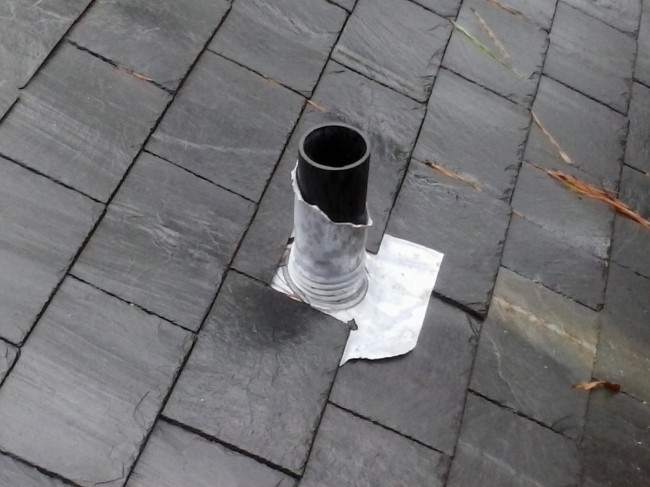
This is a good example of that. We want to thank Scott Morrow of Scott Morrow Slate & Tile Roofing & repairs out of Atlanta Georgia for letting us use his photos for the purpose of this blog. Scott Morrow has been in the slate and tile roofing business in the Atlanta | Buckhead | midtown area for over 20 years and has been giving us excellent photos of his work .
Now that being said, there is another option out there for plumbing boot replacement that will fend off them pesky squirrels and it is a plumbing boot made from 20 oz. copper! Not only does it last a long time which helps the wallet, but it looks pretty as well. Scott Morrow has performed a 20 oz. copper plumbing boot install and shared with us the before, during and after photos of it .
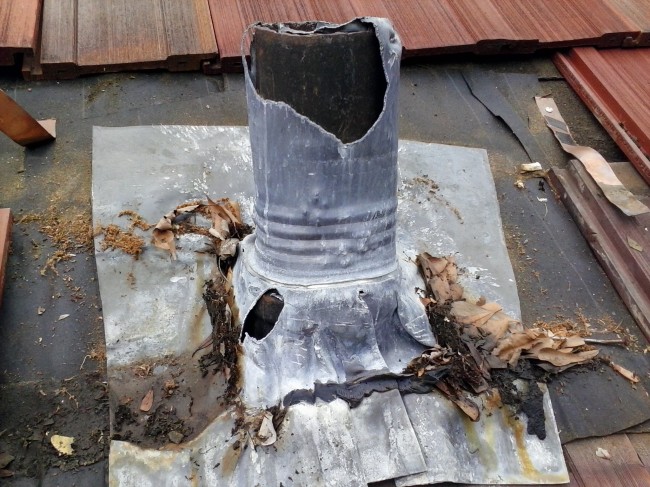
This is the before photo. You can see where the squirrels have made a hole in the base as well as took part of the top off. Scott Morrow has already removed the tile from around this pipe and you can see he is not the first one to do this by the two copper straps that are nailed to the left and the right of the pipe.
The reason for these straps is to bent in a hook form around the tile to hold it in. See you cant exactly nail in the last pieces because the other tile above them will be over top the nail holes. this is a common practice. Some actually buy copper hooks and some make them.
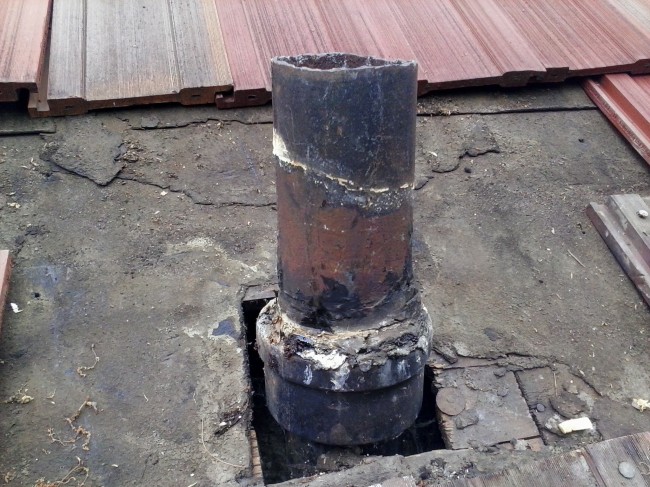 Here
is the plumbing pipe after the lead boot has been removed. Not very
pretty is it? Can you see the penny that the last roofing contractor
left? Some roofers will take a penny with the current year on it and put
it under there work. But some also say some one just dropped a penny! I
like the first version.
Here
is the plumbing pipe after the lead boot has been removed. Not very
pretty is it? Can you see the penny that the last roofing contractor
left? Some roofers will take a penny with the current year on it and put
it under there work. But some also say some one just dropped a penny! I
like the first version.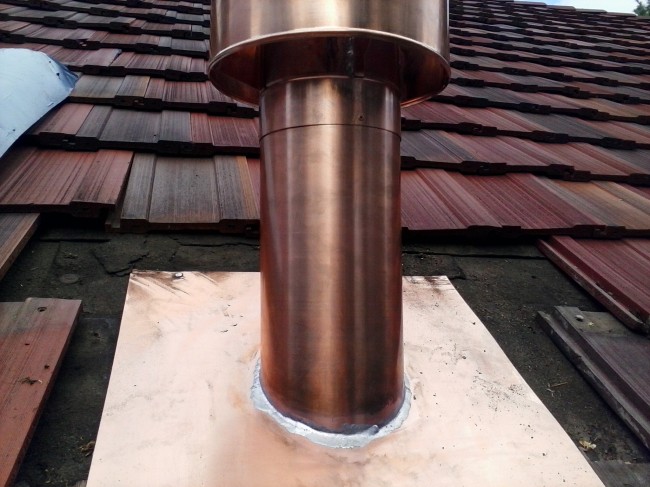 OK,
so now we have a very pretty 20 oz. copper boot in place of the lead
boot. You can see for your self how much better this looks and will
compliment any roof.
OK,
so now we have a very pretty 20 oz. copper boot in place of the lead
boot. You can see for your self how much better this looks and will
compliment any roof.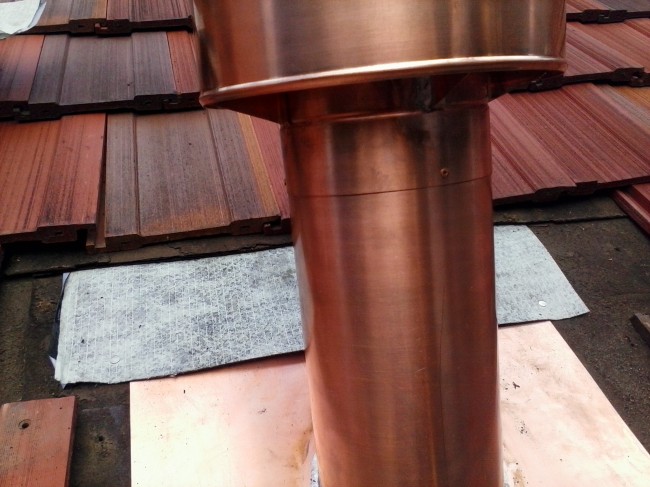
Now if you look above the copper plumbing boot you can see that Scott Morrow has taken a piece of felt paper and cut the existing roof felt and slid it under it, while covering the copper boot. The reason for this, is if there is a leak that comes from above the boot some where down the road, say maybe a branch falls and breaks a piece of tile, and water gets under the tile and rolls all the way down to the boot, it wont run under it and in to the house, it will run over top of the boot.
The felt that they put on the roof before they put tile on it is a second line of defense.
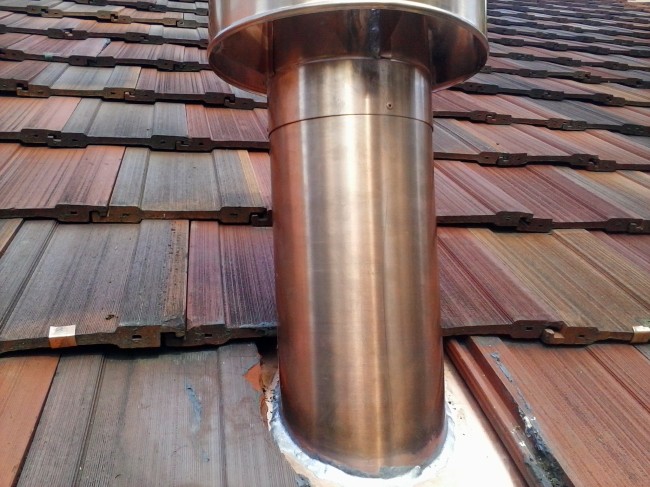
This is the finished Product! Not only does it look great but it will last forever! Again we would like to thank Scott Morrow of Scott Morrow Slate & Tile Roofing & repairs of Atlanta | Buckhead | Midtown who reminds you to Hire a roofing contractor who has slate and tile experience for your slate and tile roof system.
Tuesday, March 19, 2013
Modified Rubber Roofing Applications
There are essentially two kinds. There is modified roofing that uses a base sheet material and is simply a peel and stick solution. Then there is torch down. Where as the product is rolled out and a heat torch applied which melts the asphalt on the underside of the roll and adheres it to the roofing deck.
We want to thank Scott Morrow of Scott Morrow Slate & Tile Roofing & Repairs out of Atlanta, Georgia for letting us use pictures of his work to use as a illustration in this blog.
Scott has been great about getting pictures to us to use. Today he has given us a perfect example of how a modified rubber roof application should look when finished.
This first photo is of the damaged roof that needs to be replaced. copper would look great and last a lot longer then rubber but it might not be in your budget. As you see the last roofer just rolled the rubber up the wall.
In this picture is a very similar roof with the same roofing system used on it. But If you see, when Scott morrow replaced this roof he capped the edges that roll up the wall with a nice 20 oz. copper cap.
Sunday, March 17, 2013
Decking & Drip Edge Replacement
Today we are going to share with you some photos of decking and drip edge replacement. For those of you who are not familiar with drip edge it is made of 20 oz. copper, if on a slate or tile roof, and is installed on the edge of the roof to keep water from getting behind the facial board.
This is an example of a roofing system with out drip edge. If you can see there is a gap that needs to be covered. the reason it needs to be covered, is because there is a back draft that is created with in the attic that will pull water as it roles of the roof. Its just like an open window in the house pulls a door and slams it.
We would like to thank Scott Morrow of Scott Morrow Slate & Tile Roofing of Atlanta Georgia for letting us use his photos to illustrate this blog.
The next part of this post we are going to show you how decking and drip edge are properly replaced on a Spanish tile roofing system.
This is just part of the section that will be replaced, as you can see there are a few broken tiles that need to be replaced. It is a good idea to have your roof inspected at least once a year to avoid problems like this one. This was left unattended to the point to where it rotted all the decking beneath it.
The above photo is the first stage of the repair. you can see after the first two rows of tile were removed there is a little bit of the rotten wood exposed on the edge near the gutter.
And in this photo the right side of the decking has been replaced and covered by a new piece felt.
This is a better photo of the replaced decking. you can see they have already went in with a new drip edge and they are starting back in with the new felt. If you look you can see the old felt has been cut just above the new decking so that the new felt can slide under it.
The above photo is the finished product. Again we would like to thank Scott Morrow of Scott Morrow Slate & Tile roofing of Atlanta for letting us use these photos for the purpose of this blog.
This is an example of a roofing system with out drip edge. If you can see there is a gap that needs to be covered. the reason it needs to be covered, is because there is a back draft that is created with in the attic that will pull water as it roles of the roof. Its just like an open window in the house pulls a door and slams it.
We would like to thank Scott Morrow of Scott Morrow Slate & Tile Roofing of Atlanta Georgia for letting us use his photos to illustrate this blog.
The next part of this post we are going to show you how decking and drip edge are properly replaced on a Spanish tile roofing system.
This is just part of the section that will be replaced, as you can see there are a few broken tiles that need to be replaced. It is a good idea to have your roof inspected at least once a year to avoid problems like this one. This was left unattended to the point to where it rotted all the decking beneath it.
The above photo is the first stage of the repair. you can see after the first two rows of tile were removed there is a little bit of the rotten wood exposed on the edge near the gutter.
And in this photo the right side of the decking has been replaced and covered by a new piece felt.
This is a better photo of the replaced decking. you can see they have already went in with a new drip edge and they are starting back in with the new felt. If you look you can see the old felt has been cut just above the new decking so that the new felt can slide under it.
The above photo is the finished product. Again we would like to thank Scott Morrow of Scott Morrow Slate & Tile roofing of Atlanta for letting us use these photos for the purpose of this blog.
Subscribe to:
Comments (Atom)




.jpg)









.jpg)
.jpg)
.jpg)


.jpg)








.jpg)
.jpg)
.jpg)
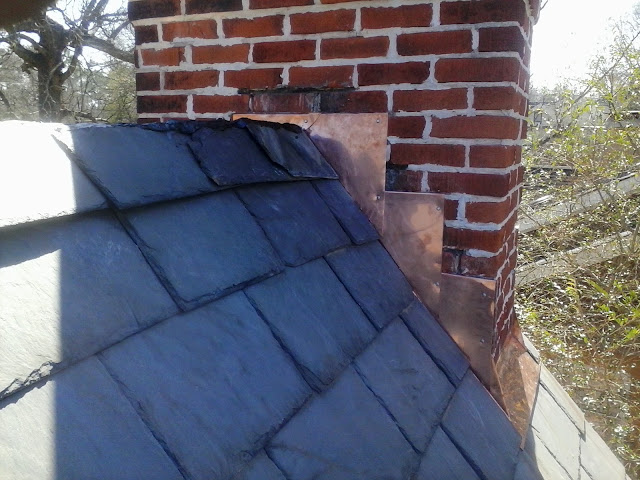
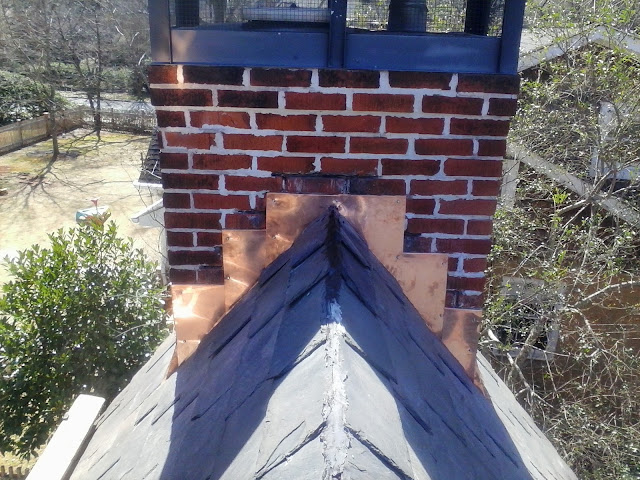
.jpg)
.jpg)
.jpg)
.jpg)

.jpg)

.jpg)
.jpg)




